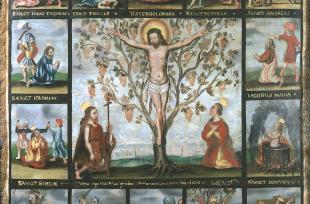The medieval stave church was extended to the west in 1844. The western part of the nave and the church vestibule is thus from more recent times. The original stave church had one nave and was surrounded by covered passageways. In the restoration of 1912-18 the onion-shaped steeple over the western part of the nave and the passageways around the building were re-constructed. Structurally Røldal stave church is different from other stave churches in that the longitudinal walls are made up of sections, thus there are interim staves between the corner staves. Also, the wall beams are jointed into the staves. The normal construction is for the staves to lie on top of the beams. The staves are finely finished with an axe, a special surface treatment that is also known from Lagmannsstova at Aga in Ullensvang.
In 1638 the church was decorated with roses and vines. The décor in the chancel ceiling is the best preserved décor, the rest was heavily restored in 1917, and the ceiling décor in the nave is new. Both the altarpiece and the pulpit have been painted by Gottfried Hendtzchell from Breslau in Schlesien in 1627-29.



